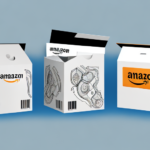Comparing FBA and FBM: What's the Difference?
When it comes to selling products on Amazon, there are two primary fulfillment methods available to sellers: Fulfillment by Amazon (FBA) and Fulfillment by Merchant (FBM). While both options have their advantages and disadvantages, understanding the differences between them is crucial in choosing which one is right for your business. Let's take a closer look at FBA and FBM and compare them across various aspects.
Understanding FBA and FBM: An Overview
Before comparing FBA and FBM, it's essential to define what each method entails.
What is FBA (Fulfillment by Amazon)?
FBA is a service provided by Amazon where sellers send their products to an Amazon fulfillment center. Amazon then handles the storage, packaging, and shipping of these products to customers. This service is particularly popular among sellers who want to outsource logistics to focus more on other aspects of their business.
- Access to Amazon's Prime program
- Increased visibility on the Amazon marketplace
- Faster shipping times
- Customer service and returns management handled by Amazon
What is FBM (Fulfillment by Merchant)?
FBM requires the seller to manage all aspects of order fulfillment, including storage, packaging, and shipping. While FBM sellers can use Amazon's shipping and delivery services, they remain responsible for inventory management.
- Full control over the fulfillment process
- Potentially lower fees for storage and fulfillment
- Better suited for unique or customized products
- Direct contact with customers
Comparing FBA and FBM
Pros and Cons of FBA and FBM
Pros of FBA
- Access to Amazon's extensive customer base and Prime program
- Faster shipping times enhance customer satisfaction
- Outsourced logistics reduce the seller's workload
- Increased product visibility and potential for higher sales
Cons of FBA
- Higher fees for product storage and fulfillment
- Less control over the fulfillment process
- Potential challenges in managing inventory levels
- Increased competition among FBA sellers on Amazon
Pros of FBM
- Complete control over the fulfillment process
- Lower fees for storage and fulfillment, especially for smaller inventories
- Ability to personalize packaging and shipping processes
- Less competition among FBM sellers on Amazon
Cons of FBM
- No access to Amazon's Prime program, which can affect visibility and sales
- Longer shipping times if not using Amazon's shipping services
- Increased responsibility for inventory management and storage
- Lower visibility on the Amazon marketplace compared to FBA
Cost Comparison: Which Fulfillment Method is Cheaper?
Cost is a significant factor when choosing between FBA and FBM. FBA fees include storage fees, fulfillment fees, and shipping fees, which can add up, especially for sellers with large inventories. FBM fees typically involve storage and shipping costs, but fulfillment fees vary based on how orders are processed.
Generally, FBA fees are higher than FBM fees, making FBM a more cost-effective option for sellers with smaller inventories or those just starting out. However, FBA can be a worthwhile investment for sellers looking to leverage Amazon's Prime program and enhance product visibility.
The cost-effectiveness of each method also depends on the size and weight of the products. Larger and heavier items may benefit from FBA's discounted shipping rates, while smaller items might be cheaper to fulfill through FBM.
Sales and Revenue Comparison: Which Fulfillment Method Generates More Sales?
Generating sales and revenue is a primary goal for any Amazon seller. Typically, FBA tends to generate more sales than FBM due to several factors:
- Prime Eligibility: FBA products are eligible for Amazon's Prime program, attracting customers who prefer quick and free shipping.
- Higher Conversion Rates: Prime-eligible products often have higher conversion rates as customers trust and prefer them.
- Increased Visibility: Amazon prioritizes FBA products in search results and during promotional events, enhancing visibility.
- Global Reach: FBA allows sellers to tap into Amazon's international fulfillment network, expanding their customer base globally.
However, while FBA can drive higher sales, it's essential to balance this with the associated costs to ensure profitability.
Shipping and Delivery Comparison: Which Fulfillment Method Offers Faster Shipping?
Shipping speed is a crucial factor for customer satisfaction. FBA offers faster shipping times through Amazon's Prime program, which guarantees expedited delivery. Additionally, FBA benefits from Amazon's international fulfillment centers, enabling quicker global shipping.
On the other hand, FBM can offer comparable shipping times if sellers utilize Amazon's shipping services. However, when using other carriers, shipping times may be longer, potentially affecting customer satisfaction.
Inventory Management Comparison: Which Fulfillment Method Offers Better Inventory Management?
Effective inventory management is vital for maintaining sales and customer satisfaction. With FBA, Amazon handles all aspects of inventory management, including storage, tracking, and fulfillment. This allows sellers to focus on other business areas without worrying about logistics.
The inventory management system provided by FBA helps maintain stock levels and updates sellers based on demand. In contrast, FBM requires sellers to manage their own inventory, ensuring they have sufficient stock to fulfill orders accurately and promptly.
Choosing the Right Fulfillment Method for Your Business
Selecting between FBA and FBM depends on your business priorities and needs. If convenience, enhanced visibility, and faster shipping are top priorities, FBA may be the better choice. Conversely, if maintaining control over inventory and fulfillment processes or reducing fees is more important, FBM could be more suitable.
How to Switch Between FBA and FBM
Switching between FBA and FBM is straightforward with Amazon's flexible fulfillment options. To switch from FBA to FBM, create new shipping templates and adjust your inventory management system. To transition from FBM to FBA, enroll your products in the FBA program and send your inventory to an Amazon fulfillment center.
Success Stories of Businesses Using FBA or FBM
Many businesses have achieved significant success by leveraging Amazon's FBA and FBM programs. FBA has enabled sellers to scale rapidly by simplifying logistics and enhancing product visibility, leading to increased sales and customer satisfaction. Meanwhile, FBM has been beneficial for sellers offering unique or customizable products, allowing them to differentiate their offerings and maintain direct customer relationships.
Common Mistakes to Avoid When Using FBA or FBM
To ensure success with either FBA or FBM, it's essential to avoid common pitfalls:
- Inaccurate Product Listings: Ensure all product information is accurate and up-to-date to avoid customer dissatisfaction.
- Over-Reliance on Amazon's Inventory Management: Even with FBA, regularly monitor your inventory levels to prevent stockouts.
- Poor Inventory Management: Whether using FBA or FBM, maintaining accurate inventory records is crucial for fulfilling orders efficiently.
- Ignoring Customer Feedback: Actively seek and respond to customer feedback to improve product offerings and customer service.
By being mindful of these mistakes, sellers can enhance their operational efficiency and maintain high levels of customer satisfaction.
In conclusion, both FBA and FBM offer distinct advantages and challenges. The right choice depends on your specific business needs, resources, and long-term goals. By thoroughly comparing FBA and FBM in terms of cost, sales potential, shipping efficiency, and inventory management, you can make an informed decision that best aligns with your business objectives.




















